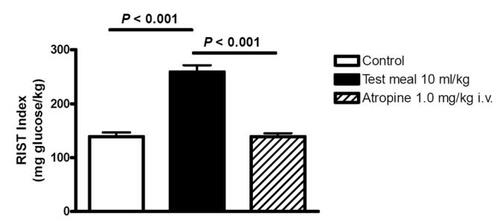Figures & data
Figure 1 Feeding results in an increase of hepatic glutathione (GSH) and a parasympathetic signal to the liver that acts, via acetylcholine, on muscarinic receptors to activate NO release which, in turn, activates adenylyl cyclase. Both of these signals are permissive and both are needed in order that insulin can cause the release of hepatic insulin sensitizing substance (HISS). HISS acts selectively on skeletal muscle. Blockade of any portion of these pathways leads to blockade of HISS release and a state of HISS-dependent insulin resistance which is physiologically regulated to occur in the fasted state but, when not activated by feeding, is suggested to account for postprandial hyperglycemia, hyperinsulinemia, hyperlipidemia, and increased oxidative stress.

Figure 2 The RIST index (mg glucose/kg body weight required to maintain euglycemia after a bolus of 50 mU/kg of insulin) increased 90 minutes after administration of a mixed liquid test meal via an indwelling gastric catheter in conscious unrestrained rats. Atropine (1 mg/kg), which blocks release of hepatic insulin sensitizing substance (HISS), completely eliminated the meal-induced insulin sensitization (MIS). The same report showed that sucrose or glucose were ineffective in activating MIS. Prior surgical denervation of the liver blocked MIS from developing (CitationSadri et al 2006).
